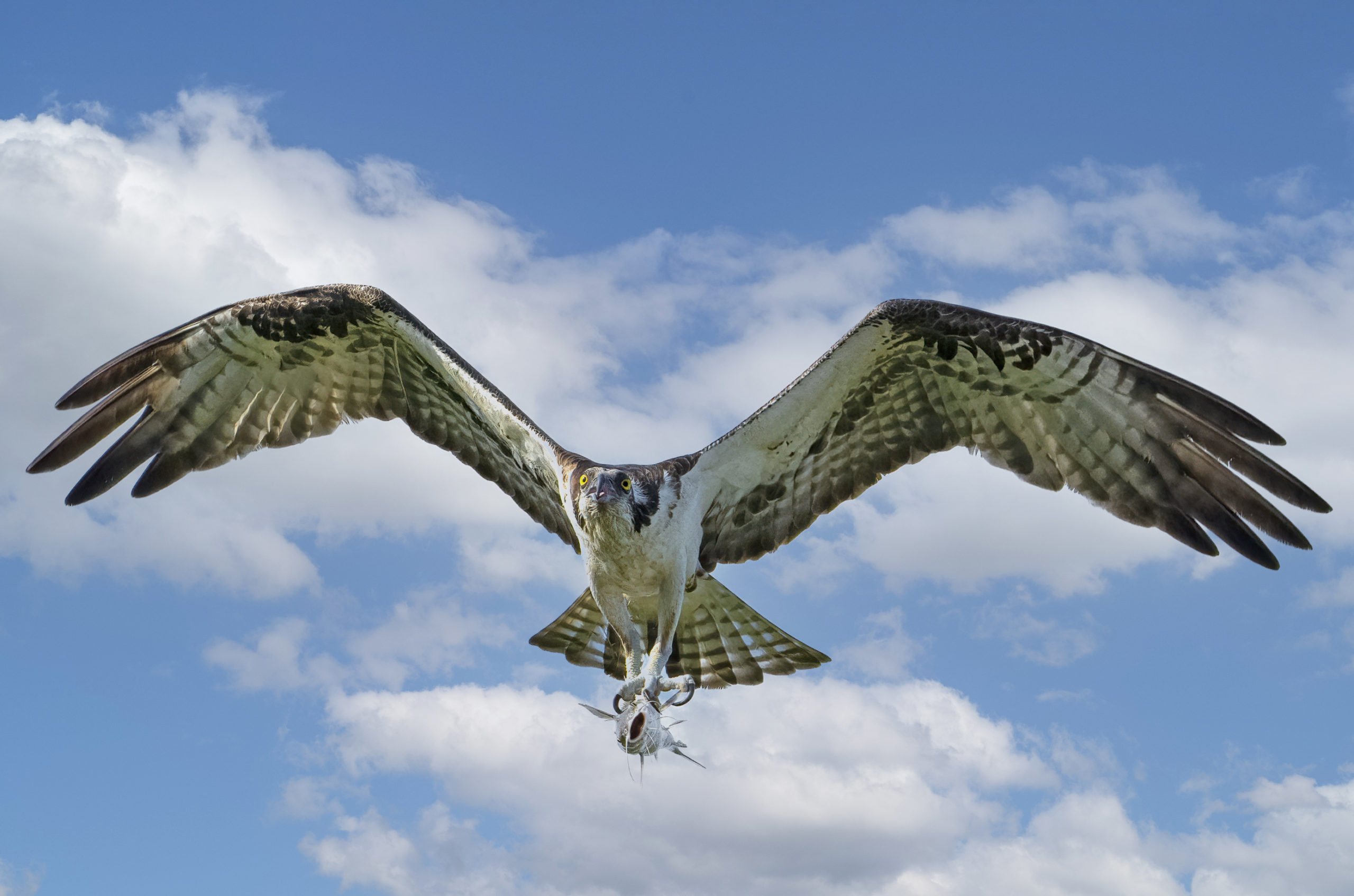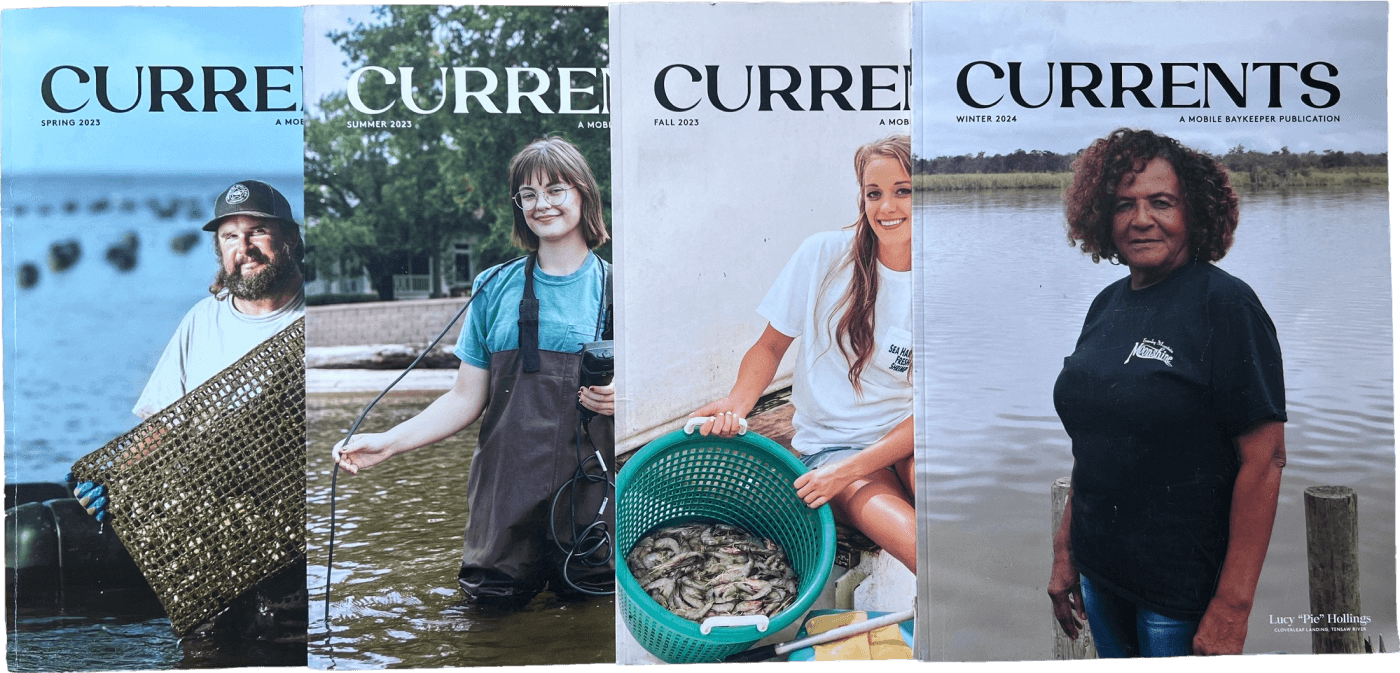
This article is from the fall edition of Mobile Baykeeper’s print quarterly, CURRENTS. The magazine is mailed to active members who have given more than $50 in 2023. To get on the magazine’s mailing list, donate here.
by Susan Rouillier
You have probably seen an osprey hover, and with almost divine precision, plunge feet-first like an arrow, breaching the water’s surface with a splash to emerge triumphant with a glimmering prize clasped tightly in its talons. Its name probably originates from the Latin, “avis prede” (bird of prey), and French, ospriet. Over time, it has been called the Sea Hawk, River Hawk, Fish Hawk, and Fish Eagle. Found on every continent except Antarctica, these large raptors have wings that span up to six feet, can weigh 4.5 pounds, fly up to 80 miles per hour, and can live as long as 30 years.
Exceptional Fishing Skills
Ospreys possess amazing physical adaptations that enhance their fish-catching prowess. With keen eyes capable of spotting fish from a height of 100 feet, they hover effortlessly with large wings and plunge at 50 mph, resulting in a phenomenal splash. Oily feathers keep them dry when diving, while nasal valves prevent water intake. Short spines on their feet called spicules aid in gripping prey, while a unique reversible outer toe allows them to better grip slippery prey and fly off with it, pointing it face first for aerodynamic reasons. These strong birds can hoist their body weight in fish, which comprise 90 percent of their diet, but they also prey on frogs, snakes, birds, and small mammals.
Where to See Ospreys Locally
Ospreys can be seen fishing along Mobile Bay and its adjoining rivers, or near their nests found in the many river bends in the Delta. They can also be seen on power poles and man-made platforms, or by Salt Creek and the Bird Sanctuary on Dauphin Island, and recently, in the wetlands park beside Gulf Shores Sportsplex. Or just by looking up in Downtown Mobile.
Conservation Success Story
At one point, Osprey populations experienced significant decline due to habitat destruction and the harmful effects of pesticides which caused eggshell thinning and reproductive issues. After the ban of DDT in the United States in 1972, Osprey populations rebounded, becoming a conservation success.
Osprey Nests: A Virtual Airbnb
Other animals and birds often use their sturdy artistic structures for their home. Tree Swallows and grackles build their own nests inside them, while Great blue herons, Bald eagles, ravens and Great- horned Owls raise chicks in them during the winter when the ospreys migrate south.
The Male: A Devoted, Monogamous Gentleman
The flirtation starts in the air, when the male does a complicated sky dance, calling all the while to impress. He will offer a branch to the female. She is choosy for a reason: to accept it means that he will be her partner for life.

The Finest Food for His Lady
Ospreys share nesting duties: the male brings materials, and the female arranges them. Nests contain sticks, reeds, grass, moss, lichen, and sometimes urban debris like nylon netting or plastic bags. Nests called eyries are reused and new sticks are added each year. The nests can be as big as five feet across and six-and-a-half-feet deep.
In April, the female lays two to three eggs, and incubates them for 37 days. Within moments after the first chick hatches, a ritual begins that will play out every day for the next two months. Dad brings in a fresh fish, while mom tears it into tender pieces and delicately feeds the chicks. But first, the male eats the entrails, and then gives the finest pieces to his lady. Older chicks rarely dominate the younger ones. In eight weeks, the young fledge, but both parents continue to provide food for the young for another two months. Adolescent ospreys can be distinguished from adults by the white tips on their wing feathers.
Do Ospreys Mourn?
It seems so. Ospreys, like pigeons and jaybirds, will perch on their empty nest near the spot where a baby died for long periods, sometimes calling out softly after their lost chick.
A Legend and Symbol for Humans
The osprey holds a unique enchantment, setting it apart from all other sky creatures. Some believe it carries sailors’ dreams, ensuring safe passage through treacherous seas. In Native American lore, an Osprey commands the same respect as the eagle, especially among coastal tribes, where it is seen as a guardian and spiritual protector. It is an exceptional and cherished presence across cultures and time.
Before moving to her current home on Mobile Bay, Susan Rouillier lived in Cuba, Japan, and Australia. She is the author of a series of books about South Mobile which are available on Amazon.
